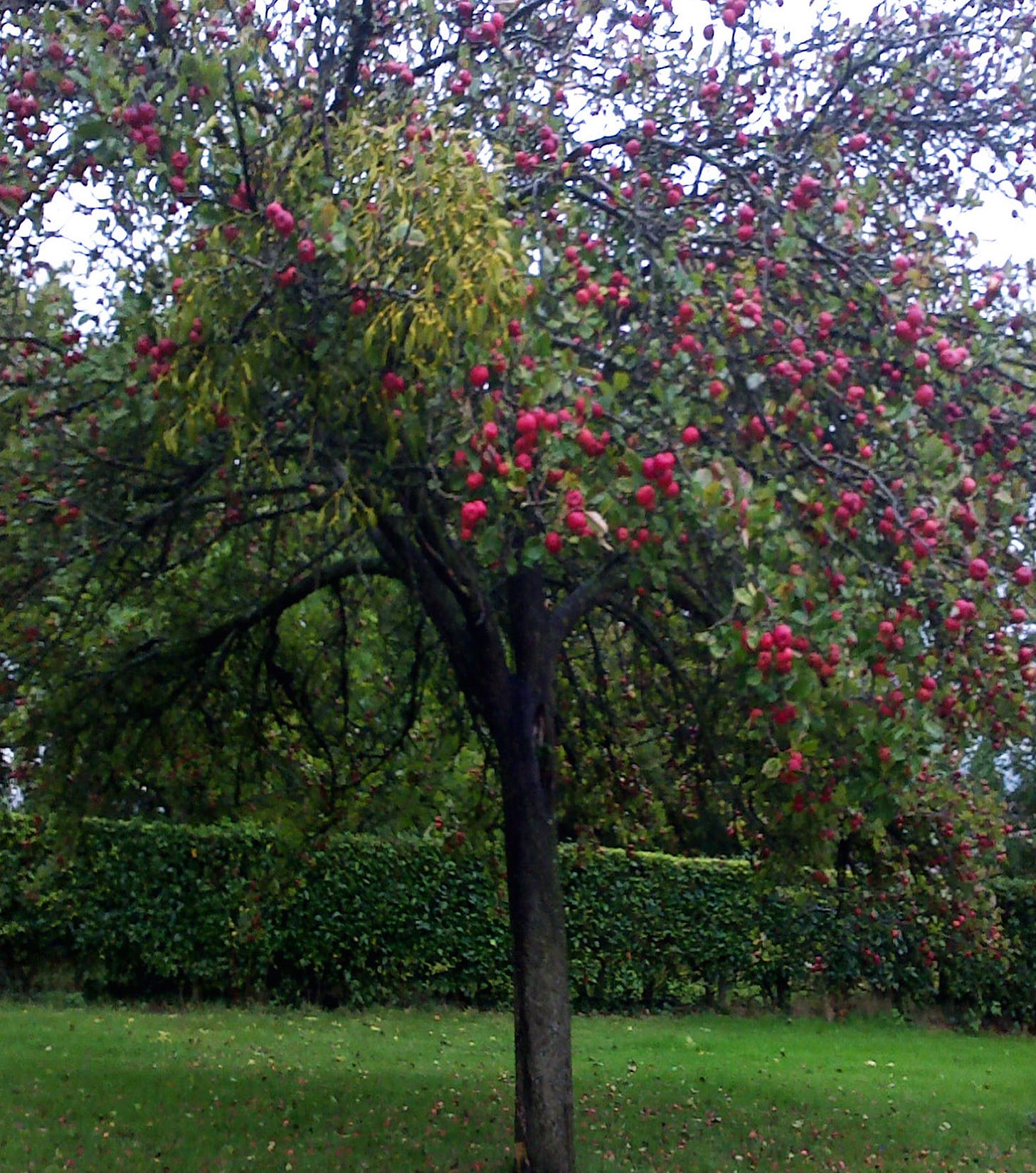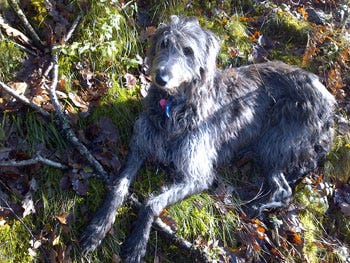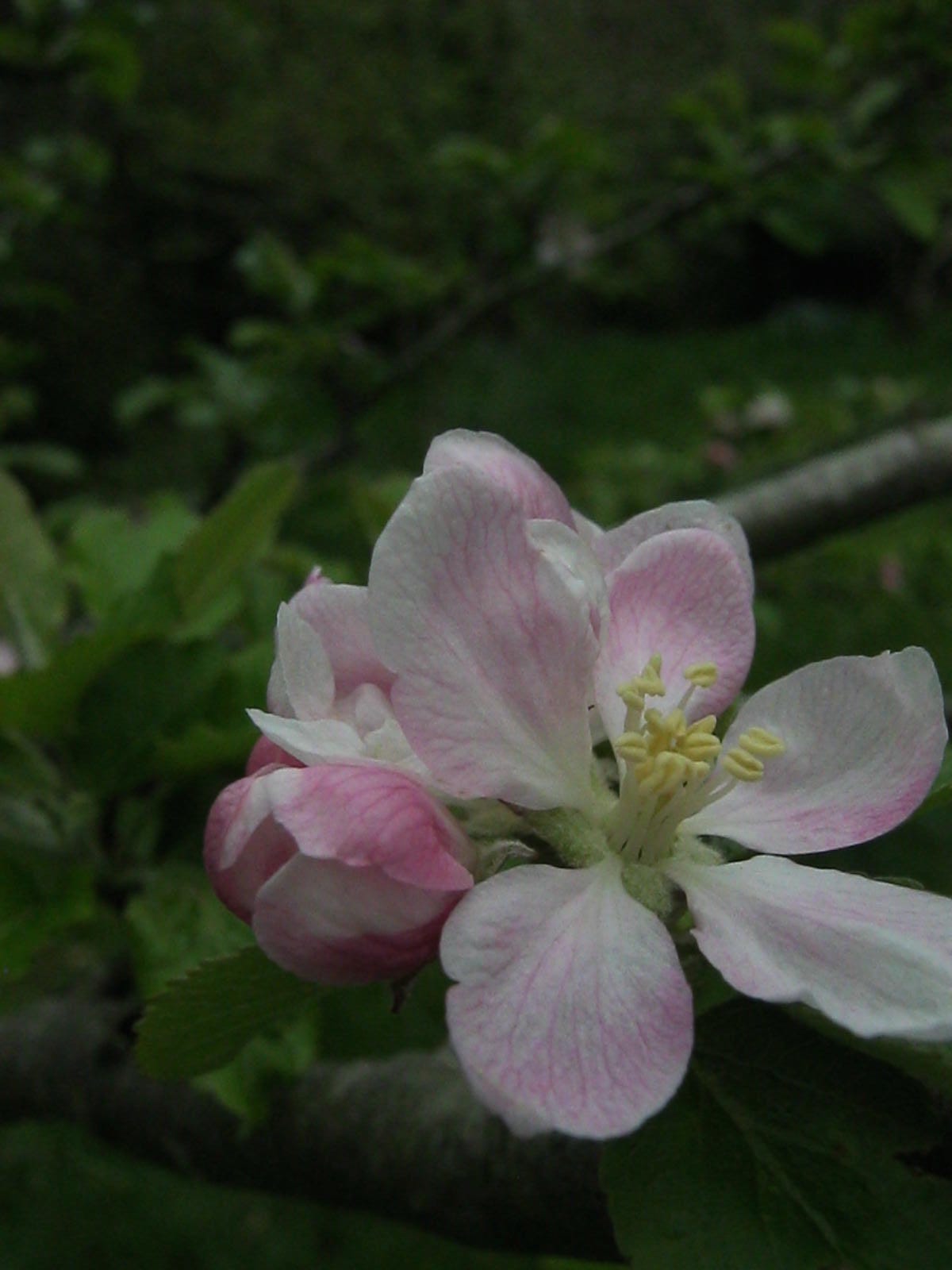To the Celts, the apple was a highly significant tree. In the version of the Ogham Tree Calendar/Alphabet by which I mark the turning points of my own year (see my book A SPELL IN THE FOREST – tongues in trees) the apple, not surprisingly, ushers in autumn. In the book I write a great deal about the esoteric and mythological ascriptions of apple, a truly magical tree; but here I’ll offer a précis only.
I’m writing this now in late winter (rather than autumn) because it’s coming up apple pruning time; and also wassailing time. In two or three weeks’ time, we’ll be planting the first 7 fruit and nut trees of our forest garden, to join the 14 native apple trees and 2 plums we planted in an arc there last winter (the harder job was putting up serious and robust deer-fencing around each one, in deep frost). These new ones will be the beginnings of our attempt to join up meadow with existing woodland.
Kazakhstan, apples & horses as go-betweens
Behind all our cultivated apple trees – and we now have approximately 20,000 varieties worldwide, with about 6000 in Britain alone – stands the beautiful wild crab apple. The crab apple, malus sylvestris, is an ancestor of them all, and is also a pollinator for every variety.
But there is an older variety altogether, behind the crab apple.
Here’s Roger Deakin, from his inspiring book Wildwood:
‘I am travelling to Kazakhstan, propelled by a story told to me by [Oxford don] Barrie Juniper... I had heard of Juniper’s pioneering work in tracking down the origins of the domestic apple to the Tien Shan Mountains of Kazakhstan. Over lunch, [Barrie] outlined the long journey of the domestic apple from the wild fruit forests of the Tien Shan along the so-called Silk Road to the west. In the course of that journey, Juniper has discovered, the wild apple of the Tien Shan, malus sieversus, evolved into the domestic apple, malus domesticus, and eventually found its way to Britain with the Romans.
‘By which time, it was already many thousands of years old (according to Juniper Malus, the botanical family to which all Apples belong, first evolved about twelve million years ago), and had also been transported west via the guts of birds, bears, horses, through which it travelled unscathed and undigested, with the livestock selecting the juiciest and sweetest Apples they could find.’ Deakin goes on to tell us that, around 7000 years ago, the horse was domesticated and plied the trade routes, bringing apples further west again.
‘The Romans, in their turn, grafted malus sieversus onto the Crab Apple, malus sylvestris, stock. And so.
‘Plant the pips of a hundred apples from the same tree and the new generation of trees can differ, often dramatically, from their parents and each other. This is how new kinds of apples have arisen by chance over the centuries.’
Learning to be an orchardist
To me, the apple is also a highly significant tree. I’ve been looking back, as you do sometimes on the run up to a new year, but today in relation to apple trees; and realised that I’ve almost never lived without at least one apple tree, even though most of my adult life I’ve rented. (My sister has always called the houses I’ve ended up in ‘Avalon’, though I hadn’t quite realised how prevalent the apple trees have been, from childhood on.)
For the last several Januarys and Februarys while I’ve been living with TM and our small Devon orchard, no matter what the weather (within reason), a ritual beginning to the year for me has been to prune the apple trees. I have found that I really love this job I initially resisted – amputating tree limbs – and am also good at it.
In Devon, once TM had gone off to work, my old deerhound and I would head up to the orchard early, and I’d begin. Pruning requires as much careful looking, and inward listening, as action: with some trees I might take off half a dozen or more branchlets to let in light and air, and remove damage and disease, with others it might just be one.
Often it would be frosty, and although I’m not fond of the cold it somehow felt like a deeply ritualistic and meditative practice that left me uplifted.
Wassailing
We also carried on the old tradition of wassailing that I had initiated in the days when I had a workshop and home in the grounds of Buckland Abbey. Commonly, wassailing happens on 17th January. A libation of cider-soaked toast (ideally the cider is made from the juice of the apples of that tree) is planted in the fork of the apple tree, a toast is drunk, songs are sung, then everyone makes a deal of harsh noise with metal dustbin lids or pots and pans, before a gun is fired into the air. The point of all this is to wake up the apple trees and scare away evil spirits.
Our own wassail is a great deal quieter, and is intended merely to thank the trees for the previous harvest, and request a good one for the following season. We respect the fact that the apple trees might not want to wake up in January. We might pour a little juice onto the roots of each tree and say a few words of thanks. Sometimes I will tie white or green or red ribbons to one or two of the branches. In my view, we are reaffirming our connection with the trees. It’s a way of focusing intention, as we share guardianship of the land with the trees and other beings.
The Bramley Orchard
When we arrived here in Brittany, very much an apple-growing region like Devon and Somerset, we knew we were coming to a Bramley orchard in a south-sloping field across the holloway from the Home Meadow. The trees here are seriously bent horizontal, like burdened old ladies; strangely, towards the west, from where the prevailing winds come. I imagine this is a straining towards the light, as they are backed by an old hedge of very tall oaks and chestnuts.
What we didn’t know for a little while, however, was that there is also another small orchard actually in the Home Meadow (which is about a hectare, much of it full of trees and shrubs and hedges, as well as the potager and my circular mandala-manqué bee, herb and perennial bed). It was so overgrown that we overlooked it. These apples are mostly cider varieties. We cleared and pruned it last winter, so this time it will be the turn of the Bramley orchard.
Our predecessors kept stock in the various fields. Here in Finistère, families inherit several small disparate parcels of land, and for us there are several that come with the farmhouse. Some are at a bit of a distance: one at least we are leaving to its own regenerative devices. In relation to another, nearer the village, I mentioned to the mairie that we’d wondered about offering it as a community orchard (yes, you’ve got it: ‘Come the Apocalypse’). As I did so, I remembered the water-park that the commune had set up and also planted with apple trees: apart from the weekly market, it’s hardly ever used. The maire had looked at me in some surprise, and pointed out that almost every house has its own apple tree or trees.
For our first year here, I was delighted to continue to home the previous occupants’ donkeys and horse, mainly in the Bramley orchard. They were gentle creatures, and it was a good arrangement: I got to hang out with some lovely animals who were very well looked after, without having to be responsible for them.
I think again of Deakin, speaking of Kazakhstan’s two great gifts to the world: ‘the cultivated apple and the tamed horse’. How different life would be, and would have been, without either of those.
He also reminds me that every Bramley apple tree, wherever it is found, owes its existence to a single Bramley tree found in a Northamptonshire garden. All these connections vibrate behind this little orchard.
When a field is more than a field
Something I’ve appreciated is that B had put a chair in every meadow. Initially I’d thought it was for him to sit down when he went to feed the sheep, donkeys or the Breton working horse. Recently, I’ve wondered if it was instead to simply sit and reflect. We’ve removed them, not being keen on the dirty-white plastic picnic chair–ishness of them, but each time I go into the Bramley orchard field I enter a deep but silently-humming zone in which I want nothing more than to sit and tree-bathe. Here, time dissolves and becomes a meaningless construct. It’s a pretty field, but it’s the apple trees who give it such a presence. Soon, it will be time to start to look at the tangled thickets of their branches and decide how to prune. Perhaps I can persuade TM to create a bench there; or indeed, make it myself.
Avalon
There is a great deal to say about the mythology of apple, as I mentioned at the beginning. For now, here’s a snippet from my book:
The apple is an archetypal tree with deep connections to the Isle of Avalon, whose name means just that. (Apple is ‘afallen’, ‘apfallen’, ‘abhal’, ‘afall’ or ‘avall’ and ‘ablach’, and variations on those in both the Brythonic Celtic tongues and the old Scottish and Irish Gaelic; it’s easy to see how Avalon developed out of these words.) As the ‘island through the mists’, Avalon was the resting-place in the Otherworld to which Morgan le Fay, healer, seer, druid priestess, poet, shape-shifter and one-time Queen of Avalon, and a Lady of the Lake, with her eight sister priestesses ferried the dying Arthur. (Her better-known incarnation as Wicked Woman has origins in both Christianity and mediaeval politics.)
Avalon has been traditionally associated with Ynys Witrin, the Glass Isle arising from the misty waters of the ancient Summer Country that once surrounded what we now know as Glastonbury Tor (a place noted for its apple orchards, previously but also now). For the Celts, Avalon was known for its abundance of orchards of golden Apples.
The Isles of the Blessed, also associated with apples, in Celtic mythology are the Hesperides in Greek mythology, the Isles of Hesper (Aphrodite, goddess of love), or Venus in the Roman culture, the evening star. (Possibly, the Hesperides were once identified with what we now know as the Hebrides – ‘Bride’s Islands’, Bride, or Brighid, being one manifestation of the Great Goddess in Britain.)
The Hesperides, like Avalon, were governed by nine wise women, and the orchard was host to a particularly special apple tree, around whose roots coiled a guardian serpent of wisdom. (Familiar motif? Once again, I write of that at some length in the book.)
Now, as dusk is coming in and the Bramleys are dissolving into it, I’ll leave you with one of my poems:
Apple Tree
Wassail night has passed and winter’s
blue flames have retreated for now.
In the orchard, a thrush stabs the last
soft apple, and another calls from the tallest
tree. If you were to come by here, come
and stand by me here, I would hold
your palm to the trunk, tell you how to open
the eyes and ears of your hand so you
could feel how again the xylem and phloem
are waking, making their long slow
streaming journey between earth and star,
if you were to come here, to come by here again.
© Roselle Angwin








So interesting the way the seasons connect us over great spaces! Joe & I are also looking forward to trimming our orchard soon, which is also made up of wild apples as old as the settlers to this land alongside newer introductions that we make in efforts to carry on stewardship into future generations :) Fascinating history, thank you for sharing.
Thankyou Roselle for your post about your apple trees. I have written extensively about the symbolism and healing properties of apple in my book:
Healing Plants of Greek Myth. Here are a few excerpts:
The old saying “an apple a day keeps the doctor away” is sound advice. Apples, eaten raw and whole, including the skin, help to protect the blood vessels from the build up of fatty deposits, help to prevent heart disease, cancer, diabetes, asthma and bronchial hypersensitivity. It is important to avoid pesticides by eating organic apples.
Apples are a rich source of phytochemicals, such as flavonoids, isoflavonoids and phenolic acids, all of which are strong antioxidants. Quercetin, one of these antioxidants, whose conjugates are only in the peel, inhibits cancer cell growth in vitro.
Different varieties of apples contain different amounts of each compound. Apples do not deteriorate during storage but apple juice loses most of its important phytochemicals.
When we slice open an apple crosswise, we reveal a pentagram of five pips, while sliced lengthwise we reveal a heart, both symbols of the goddess Aphrodite, divine guardian of harmonic order and proportion. Apparently when students began their first day at the Pythagorean mystery schools, they were each handed an apple sliced in half and asked to meditate upon it. The pentagram is a golden figure and we are reminded of it in the Homeric hymn to Aphrodite, the copper-haired goddess.
According to Apollodurus, the earth goddess Gaia produced the first sacred apple tree and gave it to the goddess Hera as a wedding present. The Ladon dragon twisted and twined, serpent-like around the tree in the Garden of the Hesperides, guarding the golden apples. Hera was a jealous goddess who tormented the illegitimate offspring of her unfaithful husband, Zeus. One of these was Hercules, who she sent to kill the Ladon dragon, in the hopes that he would not survive. But Hercules succeeded in killing the dragon, much to Hera’s annoyance.